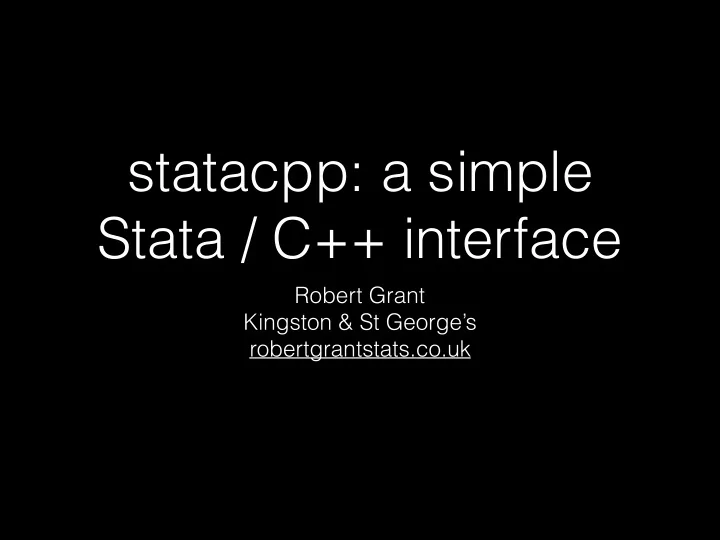

statacpp: a simple Stata / C++ interface Robert Grant Kingston & St George’s robertgrantstats.co.uk
Stata
Mata
Greata
Ada
Why? • RCpp has been very popular • interface from a data analysis- specific high-level language to a compiled fast low(er)-level language • C++ is widely used and trusted • There are many powerful libraries • You can run on multiple cores without Stata/MP
How? • Built by smashing StataStan & sticking it back together • Write code out to a .cpp text file • Add in variables, globals, matrices from Stata • Add in code to write results back into a new do-file • Shell command to compile it; shell command to run the new executable file • Do the new do-file to get the results into Stata; carry on where you left off
“they say no thing is wrote now-a-days, but low nonsense and mere bagatelle” –Alain René le Sage, 1759
Silly example • Grant’s Patented Fuel Efficiency Boosterizer • We pass the mpg variable from the auto dataset, and a global, to C++ • There, mpg values are multiplied by the global, and passed back as mpg2 • Trebles all round
Application 1 • Big(-ish) data • Let’s draw a heatmap of pickup locations for every taxi journey in New York city in 2013. • MTA dataset obtained by Chris Whong, ~50GB
NYC taxi data • Loop through each of 24 text files • No need to load to RAM; process one line at a time • Binning on rectangular grids: latitude, longitude • Simplest form of MapReduce concept • You could also extract a random sample, and don’t forget the value of sufficient statistics…
NYC taxi data • Get the latitude & longitude from line 1 • Add each line (1 taxi journey) to the relevant bin • Move to the next line • Return the binned counts to Stata as data • Draw some plots, do some analysis
NYC taxi data • But Robert, you could do that with Stata file commands • Sure, but • this can be parallelised without Stata/MP and • there are many other input streams in C++, e.g. from sensors on serial ports
Application 2 • Deep(-ish) learning • Let’s send our data through a C++ library that offers analyses we don’t have inside Stata • Fisher’s irises • Interlocked spirals (artificial data) playground.tensorflow.org
Fisher’s irises • An example from the OpenNN library • A simple neural network for classification • 4 input neurons, 6 hidden neurons in 1 layer, 3 output neurons • This is an easy problem
Interlocked spirals playground.tensorflow.org
Interlocked spirals • An artificial ‘hard’ problem • Classical statistical tools will not help • 6 input neurons (x, y, x 2 , y 2 , sin x, sin y) • 4:4 hidden neurons (2 layers [=‘deep’]) • 1 output neuron • Very hard without knowing the structure
Limitations & grumpiness • One .cpp file, limited linking capability • g++ (& makefile) only • Not even tested in W*****s • But wouldn’t it be nice to have: • StataCUDA • the reverse interface to call Stata for analysis • Don’t ask for stuff, go to github.com/robertgrant/statacpp and make it
Recommend
More recommend